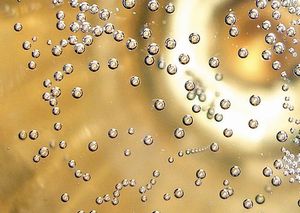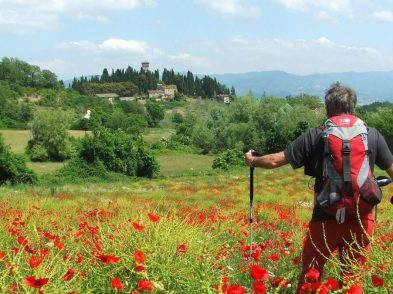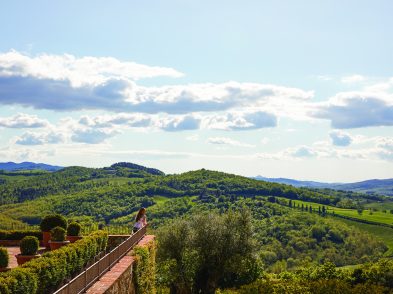It just doesn’t sound like a great idea: promoting wines made with the native negroamaro grape (also spelled neroamaro and neramaro, which means ‘black and bitter’), and with the primitivo grape, which has nothing to do with being primitive (it’s related instead to the word primaticcio, meaning ‘early,’ as this is the earliest to ripen red grape in Europe). But the winemakers of Puglia are doing just that.And they have been doing so for quite a while – 4,000 years in fact. Some sources credit the Greeks with bringing grape-growing and wine-making to Puglia; others think it began earlier, with the Phoenicians. Whatever you believe, after the Romans conquered Puglia in the 4th century B.C., it was a great source of wine for the empire. Both Virgil and Horace wrote odes praising these wines. The Goths, Byz-antines, Arabs and Lombards also overran the peninsula and greatly influenced the wine-making tradition. In fact, when the Byzantine Muslims conquered the area, they allowed winemaking to continue, since it was a great source of revenue, taxing both winemakers and product. The Normans, Spanish, and French all left their mark on the area before it joined the Kingdom of Italy in 1861. Until roughly 25 years ago, Puglia was known as the ‘cellar’ or the ‘vineyard’ of Europe. One writer said, ‘All of Puglia is virtually a vineyard.’ But its wines were primarily used for adding to other wines. Because they have a strong taste and are high in alcoholic con-tent, they were often used to add body to the wines of the North especially northern Italy, France and the rest of wine-producing Europe. Puglia has 109,000 hectares (270,000 acres) in grape cultivation, 80 percent of which are red. It ranks first among Italy’s regions with its production of 750 million liters of wine per year, 17 percent of the nation’s total wine production. However, it currently ranks 11th for ‘rated’ wines. Even now, only about 4 percent of the area’s production is produced as DOC (Denominazione di Origine Controllata) or IGT (Indicazione Geografica Tipica) wine. The DOC label lets you know that the wine is made within an officially established geo-graphic zone and with an officially prescribed grape or blend of grapes. IGT wines are subject to fewer controls than DOCs as to grape blends and production methods, but they must come from a specific geographic area. Puglia currently has 25 DOC zones and six IGT zones. According to ‘Vino Italiano: The Regional Wines of Italy,’ Puglia is ‘a great region to scour for everyday values, particularly deep, savory, well-priced reds from the local negroamaro or primitivo grapes.’ And, the southernmost part, the Salento peninsula, is the perfect place to do just that. One of the oldest wineries in the area is Leone de Castris in Salice Salento, founded in 1665 and still run by family members. Although best known for their Five Roses rosé – the first rosé bottled in Italy – they also make some excellent reds, such as the Salice Salentino (90 percent negroamaro and 10 percent black malvasia). A favorite of mine is the Donna Lisa. One reviewer said, ‘Donna Lisa is the synthesis of the Salento grapes aged in barriques. Of an intense ruby red color, it has complex aromas in which red fruits mix with sweet yet spicy notesthe flavor is full and persistent.’New to the scene in Puglia is the Marchesi di Frescobaldi. The grapes for Danzante Primitivo are selected from the province of Taranto, on hills overlooking the Ionian Sea. A reviewer said of the 2002 product, ‘it is a good value, hearty, red wine: silky textured, dry, packed with flavors and aromas suggesting herbs such as thyme and rosemary along with dry cherry fruit. Aged for nine months in stainless steel, the wine is ready to enjoy now.’ Another group currently getting a lot of attention is the Accademia dei Racemi. It was started by Gregory Perrucci and his wife, Elisa-betta Gorla, both from families with a history of wine-making. They call their firm an ‘academy’ because they want it to be a place where people who are passionate about wine and wine-making can share their knowledge to increase excellence in wines of Puglia. They use modern techniques in their vineyards and their cantina, but have the goal of keeping the real flavor of the primitivo grape in their wine. Puglia is also well known for its giant olive trees, producing huge quantities of oil, and wheat fields. Bread, olive oil and wine—the three staples of Italian life.
WEBSITES OF INTEREST:www.leonedecastris.com
www.mtvpuglia.it for Movimento Turismo del Vino Puglia








